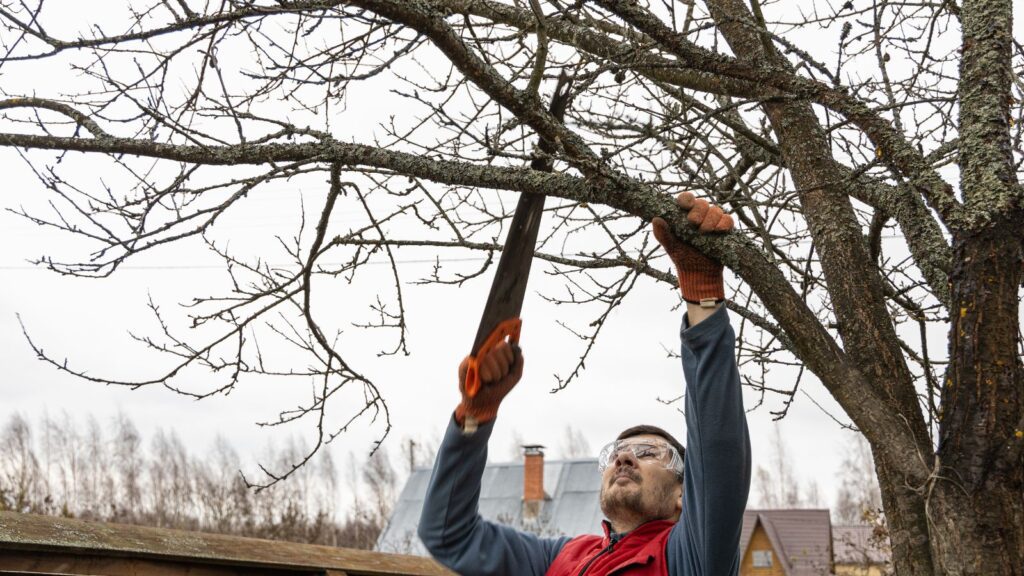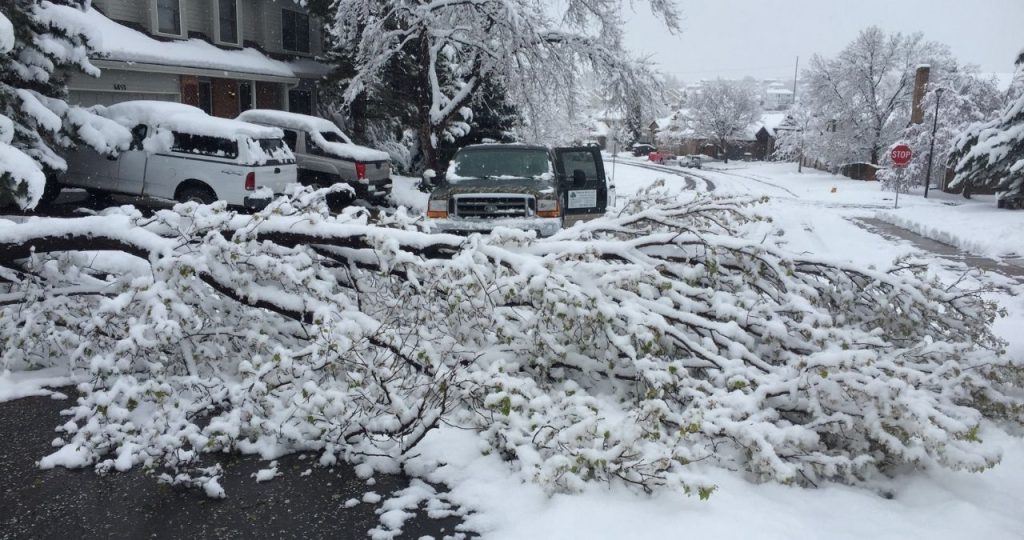Fall tree trimming is one of the most effective ways to prevent winter damage and keep your yard safe. Tree pruning in autumn helps remove dead areas and reinforce branch strength before storms hit.
Dead branches are a common cause of damage during ice storms. When ice builds up, these weak limbs can snap easily, risking harm to homes, cars, and people. Trimming dead branches in the fall reduces the chance they will break under the weight of ice, protecting property and safety during the winter holidays.
Fall is the best time to prune because the tree’s leaves have dropped, making it easier to spot dead or weak branches. Removing them early also helps the tree stay healthy and better able to handle winter weather. Proper trimming improves airflow through the canopy, reducing the risk that heavy ice will cause limbs to fall.
By taking care of trees before winter storms arrive, homeowners lower the risk of dangerous limb breaks and costly repairs. This simple step helps ensure a safer holiday season when ice storms are more likely.
Dead Branches and Ice Storms: Why Fall Tree Trimming Prevents Holiday Disasters
Understanding the Risks of Dead Branches and Ice Storms
Dead branches weaken tree structure and increase the chance of breakage during storms. Ice buildup adds weight that trees with certain features cannot support. These factors combine to create hazards, especially during winter when decoration and foot traffic increase around holiday trees.
How Dead Branches Compromise Tree Stability
Dead branches are brittle and more likely to break than healthy limbs. Even light wind or snow can snap them, creating safety risks for people and property below.
Decay often starts in dead branches, which can spread to healthy parts if not removed. This weakens the tree’s overall health.
Trees with many dead limbs are less able to handle extra weight from snow or ice. Regular fall pruning helps maintain structural balance and prevents unexpected breakage.
Ice Storm Impacts on Tree Health
Ice storms coat branches with heavy ice, especially affecting those with weak joints. Trees with fine branching or poor structure suffer more. Storm damage tree repairs are often costly and can result in long-term harm if maintenance is ignored.
Included bark, where bark grows inward at branch joints, creates weak spots prone to breaking under ice load. Trees with fine branching also suffer more damage.
Ice accumulation can lead to broken branches or entire limbs snapping off. Repair is costly and often requires professional care to avoid long-term harm.
Common Causes of Holiday Tree Disasters
Holiday tree problems often start with poor preparation. Dead branches left unpruned create weak points that snap easily under decoration weight combined with ice or snow.
Some tree species, such as Bradford pears, are especially prone to limb failure. Ignoring signs like dead limbs or unbalanced crowns increases risk. Preventive fall tree trimming reduces these threats effectively.
Advantages of Fall Tree Trimming
Trimming trees in the fall targets dead or weak branches that can cause problems during winter. This work improves safety, supports tree health, and cuts down on costly emergency repairs caused by storm damage.
Preventing Property Damage and Power Outages
Routine tree and shrub care in the fall removes dead and overgrown wood that could damage roofs, cars, fences, or power lines. Acting early helps remove dead limbs and weak branches that are more likely to break under ice or heavy snow.
By scheduling fall trimming before winter storms, homeowners reduce the risk of costly repairs, power outages, and injuries from falling branches. Removing crossing branches and weak shoots strengthens tree structure, improving resistance to strong winds and icy buildups.
Enhancing Tree Health for Winter
Autumn is part of the growing season transition, making it an ideal time to prune. Removing diseased or dead material promotes longer-term vitality. Proper pruning improves airflow and allows more light penetration through branches.
It’s easier to see the tree’s structure without leaves, making it simpler to identify problem areas. Proper pruning improves airflow and light penetration, which aids the tree’s overall health.
Fall trimming prepares trees for better growth in spring by preventing damage caused by heavy ice build-up and reducing stress on limbs.
Reducing Emergency Tree Removal Costs
Taking care of weak or damaged branches before winter helps avoid costly emergency tree removal when branches break unexpectedly. Emergency services often charge much more than routine maintenance.
When branches fall during storms, clean-up and repair can be expensive and dangerous. Fall trimming lowers these risks by addressing potential problems early.
Timely removal of hazardous limbs saves money and ensures homes and yards remain safe throughout winter weather.
Effective Tree Trimming Techniques for Autumn
During fall tree trimming, focus on proper pruning cuts that heal cleanly. Identify hazardous branches and remove them at the right angles for strong regrowth.
Identifying Hazardous Branches
Look for branches that are dead, cracked, or hanging loosely. These are likely to break under the weight of snow or ice. Also, check for signs of disease such as discolored bark or fungal growth.
Branches growing toward power lines or over structures are dangerous. Remove them to reduce the risk of damage during storms. It helps to trim when leaves have fallen, making branches easier to see.
Mark or note branches that are weak or split. These can become hazardous during ice storms, threatening both the tree’s health and nearby safety.
Proper Pruning Practices for Fall
Use sharp, clean tools to make smooth cuts that heal quickly. Cut at the branch collar, or the swollen area where the branch meets the trunk, to avoid harming the tree.
Prune smaller branches first, then move to larger ones. Remove no more than 25% of the tree’s canopy in one session to reduce stress.
Avoid topping trees, which can lead to weak regrowth. Instead, focus on thinning the canopy to improve air flow and reduce ice buildup.
After cutting, dispose of dead branches to prevent disease and pests.
Safety Considerations During Trimming
Use gloves, helmets, and safety glasses when trimming trees on your property. Work in daylight and avoid trimming in windy or icy conditions.
Use ladders carefully, placing them on stable ground. If branches are high or large, consider using ropes or other safety equipment.
Be cautious of overhead power lines. If branches are close to electrical wires, contact professionals, as this can be very dangerous.
Clear the work area of obstacles to prevent trips and falls.
Professional vs. DIY Tree Maintenance
DIY trimming can work for small branches and simple tasks. Homeowners should have basic knowledge of pruning techniques and safety.
For large trees, high branches, or complex cuts, professionals are better equipped. They have the right tools, training, and insurance.
Arborists help maintain the long-term health of trees while minimizing property risks. It also ensures that pruning is done at the right time to support the tree’s health through winter.
Long-Term Benefits of Seasonal Tree Care
Proper tree care in the fall helps maintain healthy, attractive trees that stand up to harsh weather. It also prepares trees to grow stronger and fuller when spring arrives. These benefits help protect the property and add value over time.
Boosting Curb Appeal During the Holidays
Fall tree trimming removes dead or broken branches that make trees look unhealthy or messy. Clean, well-shaped trees create a neat and inviting appearance around the home.
Trimming before winter, especially before ice or snowstorms, lowers the risk of falling branches that can damage decorations, cars, or power lines during the holidays. Well-maintained trees also provide better spacing for holiday lights.
Regular care ensures the yard looks its best when guests visit. Healthy trees add value and show attention to property upkeep, important during the busy holiday season.
Encouraging New Growth in Spring
Removing dead or overcrowded branches in the fall helps trees focus energy on new buds and shoots in spring. Trimming opens up the tree’s canopy, allowing more sunlight and air to reach inner branches.
More sunlight and airflow reduce pest and disease problems. This leads to stronger, faster-growing branches and fuller foliage when warm weather returns.
Seasonal pruning also helps trees develop a solid structure. This reduces future damage from storms and promotes long-lasting health, so trees continue to thrive year after year.
Frequently Asked Questions
Trimming trees before winter helps reduce risks like broken branches and damage from heavy snow or ice. It improves tree health and lowers safety hazards near homes and power lines.
What are the risks of not trimming trees before winter sets in?
Untrimmed trees may have weak or dead branches that break under snow or ice. These falling branches can damage roofs, vehicles, and power lines. It also increases the chance of tree diseases spreading.
How can ice storms affect the health and stability of trees?
Ice storms add heavy weight to branches, causing them to snap or split. This can lead to lasting damage, like cracked trunks or uprooted trees. Ice buildup affects trees with weak or dead branches the most.
Why is fall the ideal time for tree trimming and pruning?
Choosing to prune in the fall ensures trees enter dormancy in strong condition, prepared to endure winter storms and grow vigorously come spring. Dead and weak branches are easier to spot and remove. Pruning now helps trees prepare for winter and stops disease spread.
What measures can homeowners take to protect trees from winter damage?
Homeowners should remove dead branches and check for weak limbs. Applying mulch around tree bases helps maintain soil moisture. Avoid heavy pruning right before heavy snow or ice events.
How does professional tree trimming prevent potential holiday disasters?
Professionals remove risky branches that could break during storms. They balance the tree structure to reduce wind damage. This lowers the chances of branches falling on homes or causing power outages during winter.
What signs should I look for to determine if my tree needs trimming before winter?
Look for dead, cracked, or hanging branches. Notice any branches rubbing against each other or the house. Trees with large crowns or thin, weak branches need attention before storms arrive.
Tree Services of Omaha – Tree Removal Services
Tree Services of Omaha, Nebraska is a full-service tree care provider that offers a wide range of arborist services, including but not limited to: Tree Removal Services, Tree Trimming, Tree Pruning, Tree and shrubs Shaping, Stump Removal, Stump Grinding, Emerald Ash Borer Treatment, Arborist Consultations, Systemic Tree Injection (Tree Healthcare).
Contact us today for a free estimate!



